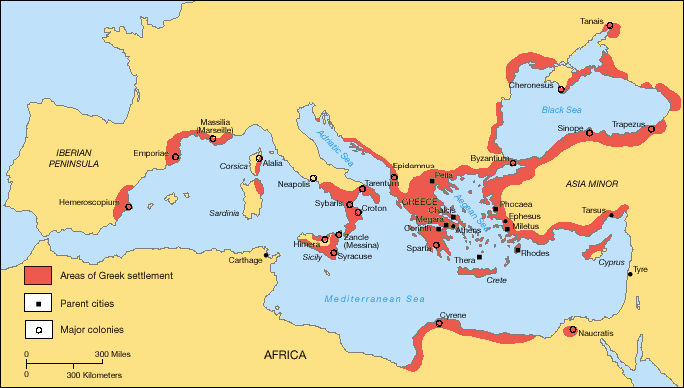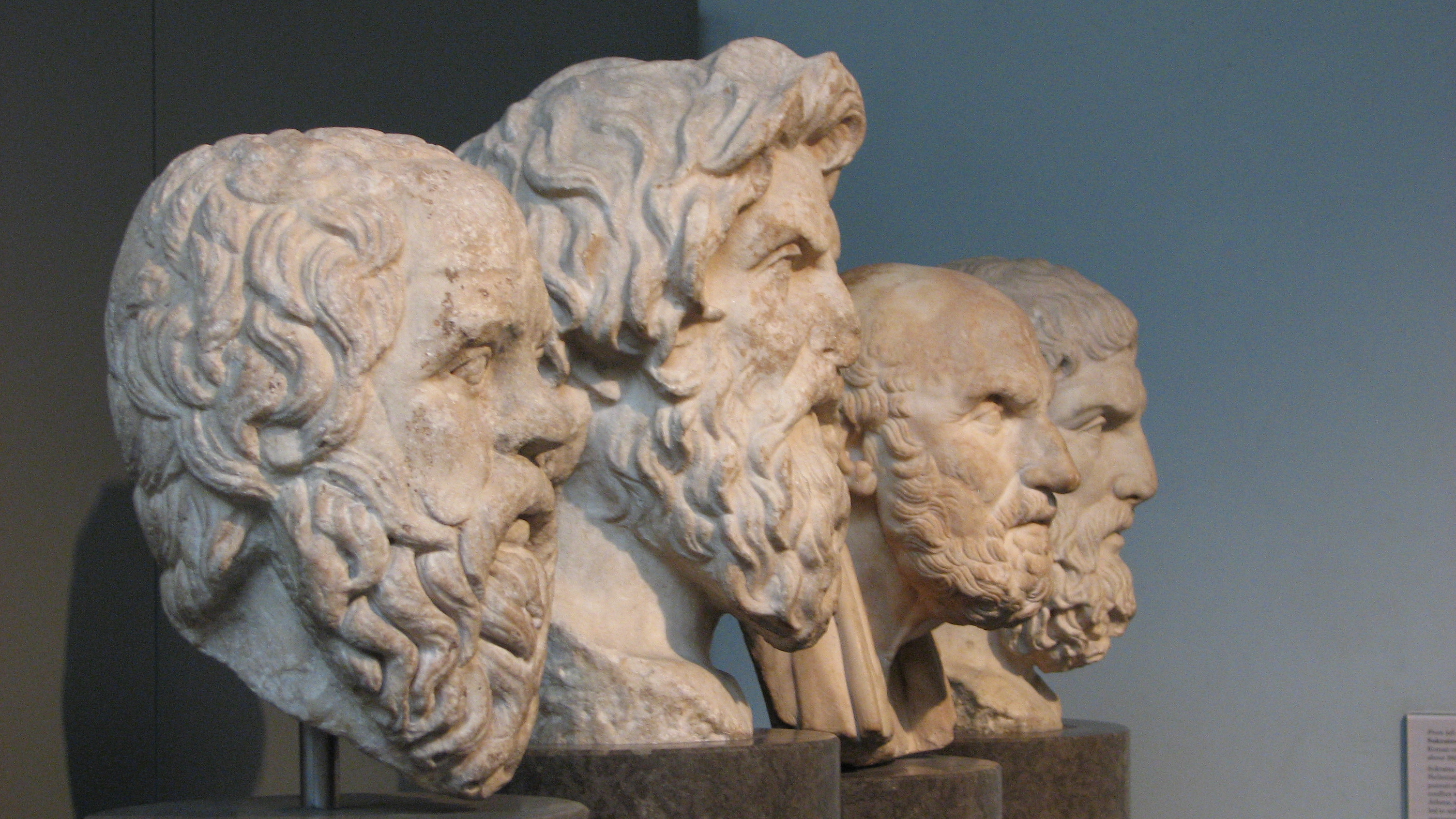|
Apeiron
''Apeiron'' (; ) is a Greek word meaning '(that which is) unlimited; boundless; infinite; indefinite' from ''a-'' 'without' and ''peirar'' 'end, limit; boundary', the Ionic Greek form of ''peras'' 'end, limit, boundary'. Origin of everything The ''apeiron'' is central to the cosmological theory created by Anaximander, a 6th-century BC pre-Socratic Greek philosopher whose work is mostly lost. From the few existing fragments, we learn that he believed the beginning or ultimate reality ('' arche'') is eternal and infinite, or boundless (''apeiron''), subject to neither old age nor decay, which perpetually yields fresh materials from which everything we can perceive is derived. ''Apeiron'' generated the opposites (hot–cold, wet–dry, etc.) which acted on the creation of the world (cf. Heraclitus). Everything is generated from ''apeiron'' and then it is destroyed by going back to ''apeiron'', according to necessity. He believed that infinite worlds are generated from ''apeiron ... [...More Info...] [...Related Items...] OR: [Wikipedia] [Google] [Baidu] |
Anaximander
Anaximander ( ; ''Anaximandros''; ) was a Pre-Socratic philosophy, pre-Socratic Ancient Greek philosophy, Greek philosopher who lived in Miletus,"Anaximander" in ''Chambers's Encyclopædia''. London: George Newnes Ltd, George Newnes, 1961, Vol. 1, p. 403. a city of Ionia (in modern-day Turkey). He belonged to the Milesian school and learned the teachings of his master Thales. He succeeded Thales and became the second master of that school where he counted Anaximenes of Miletus, Anaximenes and, arguably, Pythagoras amongst his pupils. Little of his life and work is known today. According to available historical documents, he is the first philosopher known to have written down his studies, although only one fragment of his work remains. Fragmentary testimonies found in documents after his death provide a portrait of the man. Anaximander was an early proponent of science and tried to observe and explain different aspects of the universe, with a particular cosmogony, interest in its ... [...More Info...] [...Related Items...] OR: [Wikipedia] [Google] [Baidu] |
Pre-Socratic Philosophy
Pre-Socratic philosophy, also known as early Greek philosophy, is ancient Greek philosophy before Socrates. Pre-Socratic philosophers were mostly interested in cosmology, the beginning and the substance of the universe, but the inquiries of these early philosophers spanned the workings of the natural world as well as human society, ethics, and religion. They sought explanations based on natural law rather than the actions of gods. Their work and writing has been almost entirely lost. Knowledge of their views comes from ''testimonia'', i.e. later authors' discussions of the work of pre-Socratics. Philosophy found fertile ground in the ancient Greek world because of the close ties with neighboring civilizations and the rise of autonomous civil entities, '' poleis''. Pre-Socratic philosophy began in the 6th century BC with the three Milesians: Thales, Anaximander, and Anaximenes. They all attributed the '' arche'' (a word that could take the meaning of "origin", "substance" or ... [...More Info...] [...Related Items...] OR: [Wikipedia] [Google] [Baidu] |
Arche
In philosophy and science, a first principle is a basic proposition or assumption that cannot be deduced from any other proposition or assumption. First principles in philosophy are from first cause attitudes and taught by Aristotelians, and nuanced versions of first principles are referred to as postulates by Kantians. In mathematics and formal logic, first principles are referred to as axioms or postulates. In physics and other sciences, theoretical work is said to be from first principles, or '' ab initio'', if it starts directly at the level of established science and does not make assumptions such as empirical model and parameter fitting. "First principles thinking" consists of decomposing things down to the fundamental axioms in the given arena, before reasoning up by asking which ones are relevant to the question at hand, then cross referencing conclusions based on chosen axioms and making sure conclusions do not violate any fundamental laws. Physicists include counterint ... [...More Info...] [...Related Items...] OR: [Wikipedia] [Google] [Baidu] |
Ancient Greek Philosophy
Ancient Greek philosophy arose in the 6th century BC. Philosophy was used to make sense of the world using reason. It dealt with a wide variety of subjects, including astronomy, epistemology, mathematics, political philosophy, ethics, metaphysics, ontology, logic, biology, rhetoric and aesthetics. Greek philosophy continued throughout the Hellenistic period and later evolved into Roman philosophy. Greek philosophy has influenced much of Western culture since its inception, and can be found in many aspects of public education. Alfred North Whitehead once claimed: "The safest general characterization of the European philosophical tradition is that it consists of a series of footnotes to Plato". Clear, unbroken lines of influence lead from ancient Greek and Hellenistic philosophers to Roman philosophy, early Islamic philosophy, medieval scholasticism, the European Renaissance and the Age of Enlightenment. Greek philosophy was influenced to some extent by the older wisdom litera ... [...More Info...] [...Related Items...] OR: [Wikipedia] [Google] [Baidu] |
Greek Primordial Deities
In Greek mythology, the primordial deities are the first generation of Deity, gods and goddesses. These deities represented the fundamental forces and physical foundations of the world and were generally not actively worshipped, as they, for the most part, were not given human characteristics; they were instead personifications of places or Abstraction, abstract concepts. Hesiod, in his ''Theogony'', considers the first beings (after Chaos (cosmogony)#Greco-Roman tradition, Chaos) to be Erebus, Gaia, Tartarus, Eros and Nyx. Gaia and Uranus (mythology), Uranus, whose severed genitals created the goddess Aphrodite from sea foam, in turn gave birth to the Titan (mythology), Titans, and the Cyclopes. The Titans Cronus and Rhea (mythology), Rhea then gave birth to the generation of the Twelve Olympians, Olympians: Zeus, Poseidon, Hades, Hestia, Hera and Demeter. They Titanomachy, overthrow the Titans, with the Zeus#Ascension to power, reign of Zeus marking the end of the period of warf ... [...More Info...] [...Related Items...] OR: [Wikipedia] [Google] [Baidu] |
Ancient Greek
Ancient Greek (, ; ) includes the forms of the Greek language used in ancient Greece and the classical antiquity, ancient world from around 1500 BC to 300 BC. It is often roughly divided into the following periods: Mycenaean Greek (), Greek Dark Ages, Dark Ages (), the Archaic Greece, Archaic or Homeric Greek, Homeric period (), and the Classical Greece, Classical period (). Ancient Greek was the language of Homer and of fifth-century Athens, fifth-century Athenian historians, playwrights, and Ancient Greek philosophy, philosophers. It has contributed many words to English vocabulary and has been a standard subject of study in educational institutions of the Western world since the Renaissance. This article primarily contains information about the Homeric Greek, Epic and Classical periods of the language, which are the best-attested periods and considered most typical of Ancient Greek. From the Hellenistic period (), Ancient Greek was followed by Koine Greek, which is regar ... [...More Info...] [...Related Items...] OR: [Wikipedia] [Google] [Baidu] |
Tartarus
In Greek mythology, Tartarus (; ) is the deep abyss that is used as a dungeon of torment and suffering for the wicked and as the prison for the Titans. Tartarus is the place where, according to Plato's '' Gorgias'' (), souls are judged after death and where the wicked received divine punishment. Tartarus appears in early Greek cosmology, such as in Hesiod's ''Theogony'', where the personified Tartarus is described as one of the earliest beings to exist, alongside Chaos and Gaia (Earth). Greek mythology In Greek mythology, Tartarus is both a deity and a place in the underworld. As a deity In the Greek poet Hesiod's ''Theogony'' ( late 8th century BC), Tartarus was the third of the primordial deities, following after Chaos and Gaia (Earth), and preceding Eros, and was the father, by Gaia, of the monster Typhon. According to Hyginus, Tartarus was the offspring of Aether and Gaia. As a location Hesiod asserts that a bronze anvil falling from heaven woul ... [...More Info...] [...Related Items...] OR: [Wikipedia] [Google] [Baidu] |
Abyss (religion)
In the Bible, the abyss is an unfathomably deep or boundless place. The term comes from the Greek language, Greek word ''abyssos'' (), meaning "deep, unfathomable, boundless". It is used as both an adjective and a noun. It appears in the Septuagint, which is the earliest Greek translation of the Hebrew Bible, and in the New Testament. It translates the Hebrew words ''tehom, tehóm'' (), ''ṣulā'' ( "sea-deep, deep flood") and the name of the sea monster ''rahab (term), rahab'' ( "spacious place; rage, fierceness, insolence, pride.") The Book of Jonah portrays the prophet's near death experience and his descent to the abyss. In the original sense of the Hebrew ''tehóm'', the abyss was the primordial waters or Chaos (cosmogony), chaos out of which the ordered world was created (). The term could also refer literally to the depths of the sea, the deep source of a spring or the interior of the Earth. In a later extended sense in intertestamental Jewish literature, the abyss was th ... [...More Info...] [...Related Items...] OR: [Wikipedia] [Google] [Baidu] |
Philosopher
Philosophy ('love of wisdom' in Ancient Greek) is a systematic study of general and fundamental questions concerning topics like existence, reason, knowledge, Value (ethics and social sciences), value, mind, and language. It is a rational and critical inquiry that reflects on its methods and assumptions. Historically, many of the individual sciences, such as physics and psychology, formed part of philosophy. However, they are considered separate academic disciplines in the modern sense of the term. Influential traditions in the history of philosophy include Western philosophy, Western, Islamic philosophy, Arabic–Persian, Indian philosophy, Indian, and Chinese philosophy. Western philosophy originated in Ancient Greece and covers a wide area of philosophical subfields. A central topic in Arabic–Persian philosophy is the relation between reason and revelation. Indian philosophy combines the Spirituality, spiritual problem of how to reach Enlightenment in Buddhism, enlighten ... [...More Info...] [...Related Items...] OR: [Wikipedia] [Google] [Baidu] |
Pherecydes Of Syros
Pherecydes of Syros (; ; fl. 6th century BCE) was an Ancient Greek mythographer and proto-philosopher from the island of Syros. Little is known about his life and death. Some ancient testimonies counted Pherecydes among the Seven Sages of Greece, although he is generally believed to have lived in the generation after them. Others claim he may have been a teacher of Pythagoras, a student of Pittacus, or a well-traveled autodidact who had studied secret Phoenician books. Pherecydes wrote a book on cosmogony, known as the "Pentemychos" or "Heptamychos". He was considered the first writer to communicate philosophical ideas in prose as opposed to verse. However, other than a few short fragments preserved in quotations from other ancient philosophers and a long fragment discovered on an Egyptian papyrus, his work is lost. However, it survived into the Hellenistic period and a significant amount of its content can be conjectured indirectly through ancient testimonies. His cosmogony wa ... [...More Info...] [...Related Items...] OR: [Wikipedia] [Google] [Baidu] |
Vedic
upright=1.2, The Vedas are ancient Sanskrit texts of Hinduism. Above: A page from the '' Atharvaveda''. The Vedas ( or ; ), sometimes collectively called the Veda, are a large body of religious texts originating in ancient India. Composed in Vedic Sanskrit, the texts constitute the oldest layer of Sanskrit literature and the oldest scriptures of Hinduism. There are four Vedas: the Rigveda, the Yajurveda, the Samaveda and the Atharvaveda. Each Veda has four subdivisions – the Samhitas ( mantras and benedictions), the Brahmanas (commentaries on and explanation of rituals, ceremonies and sacrifices – Yajñas), the Aranyakas (text on rituals, ceremonies, sacrifices and symbolic-sacrifices), and the Upanishads (texts discussing meditation, philosophy and spiritual knowledge).Gavin Flood (1996), ''An Introduction to Hinduism'', Cambridge University Press, , pp. 35–39A Bhattacharya (2006), ''Hindu Dharma: Introduction to Scriptures and Theology'', , pp. 8–14; George ... [...More Info...] [...Related Items...] OR: [Wikipedia] [Google] [Baidu] |






